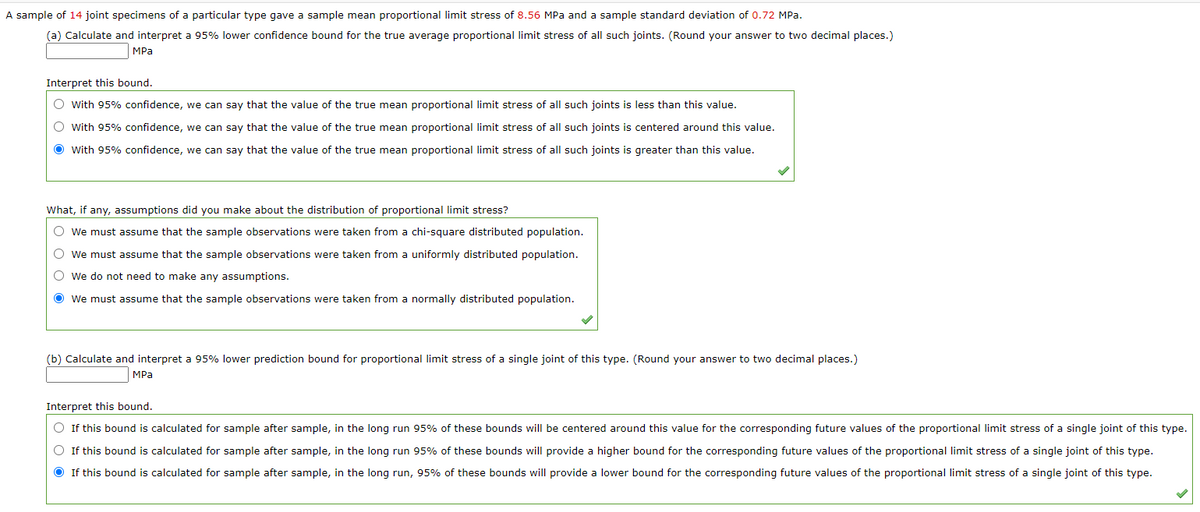sample of 14 joint specimens of a particular type gave a sample mean proportional limit stress of 8.56 MPa and a sample standard deviation of 0.72 MPa. (a) Calculate and interpret a 95% lower confidence bound for the true average proportional limit stress of all such joints. (Round your answer to two decimal places.) MPa Interpret this bound. O with 95% confidence, we can say that the value of the true mean proportional limit stress of all such joints is less than this value. O with 95% confidence, we can say that the value of the true mean proportional limit stress of all such joints is centered around this value. O with 95% confidence, we can say that the value of the true mean proportional limit stress of all such joints is greater than this value. What, if any, assumptions did you make about the distribution of proportional limit stress? O we must assume that the sample observations were taken from a chi-square distributed population. O we must assume that the sample observations were taken from a uniformly distributed population. O we do not need to make any assumptions.
sample of 14 joint specimens of a particular type gave a sample mean proportional limit stress of 8.56 MPa and a sample standard deviation of 0.72 MPa. (a) Calculate and interpret a 95% lower confidence bound for the true average proportional limit stress of all such joints. (Round your answer to two decimal places.) MPa Interpret this bound. O with 95% confidence, we can say that the value of the true mean proportional limit stress of all such joints is less than this value. O with 95% confidence, we can say that the value of the true mean proportional limit stress of all such joints is centered around this value. O with 95% confidence, we can say that the value of the true mean proportional limit stress of all such joints is greater than this value. What, if any, assumptions did you make about the distribution of proportional limit stress? O we must assume that the sample observations were taken from a chi-square distributed population. O we must assume that the sample observations were taken from a uniformly distributed population. O we do not need to make any assumptions.
A First Course in Probability (10th Edition)
10th Edition
ISBN:9780134753119
Author:Sheldon Ross
Publisher:Sheldon Ross
Chapter1: Combinatorial Analysis
Section: Chapter Questions
Problem 1.1P: a. How many different 7-place license plates are possible if the first 2 places are for letters and...
Related questions
Question
Please solve the screenshot, thanks!!

Transcribed Image Text:A sample of 14 joint specimens of a particular type gave a sample mean proportional limit stress of 8.56 MPa and a sample standard deviation of 0.72 MPa.
(a) Calculate and interpret a 95% lower confidence bound for the true average proportional limit stress of all such joints. (Round your answer to two decimal places.)
MPа
Interpret this bound.
O with 95% confidence, we can say that the value of the true mean proportional limit stress of all such joints is less than this value.
O with 95% confidence, we can say that the value of the true mean proportional limit stress of all such joints is centered around this value.
O with 95% confidence, we can say that the value of the true mean proportional limit stress of all such joints is greater than this value.
What, if any, assumptions did you make about the distribution of proportional limit stress?
O we must assume that the sample observations were taken from a chi-square distributed population.
O we must assume that the sample observations were taken from a uniformly distributed population.
O we do not need to make any assumptions.
O we must assume that the sample observations were taken from a normally distributed population.
(b) Calculate and interpret a 95% lower prediction bound for proportional limit stress of a single joint of this type. (Round
answer to two decimal places.)
MPа
Interpret this bound.
O If this bound is calculated for sample after sample, in the long run 95% of these bounds will be centered around this value for the corresponding future values of the proportional limit stress of a single joint of this type.
O If this bound is calculated for sample after sample, in the long run 95% of these bounds will provide a higher bound for the corresponding future values of the proportional limit stress of a single joint of this type.
O If this bound is calculated for sample after sample, in the long run, 95% of these bounds will provide a lower bound for the corresponding future values of the proportional limit stress of a single joint of this type.
Expert Solution
This question has been solved!
Explore an expertly crafted, step-by-step solution for a thorough understanding of key concepts.
This is a popular solution!
Trending now
This is a popular solution!
Step by step
Solved in 3 steps

Knowledge Booster
Learn more about
Need a deep-dive on the concept behind this application? Look no further. Learn more about this topic, probability and related others by exploring similar questions and additional content below.Recommended textbooks for you

A First Course in Probability (10th Edition)
Probability
ISBN:
9780134753119
Author:
Sheldon Ross
Publisher:
PEARSON


A First Course in Probability (10th Edition)
Probability
ISBN:
9780134753119
Author:
Sheldon Ross
Publisher:
PEARSON
